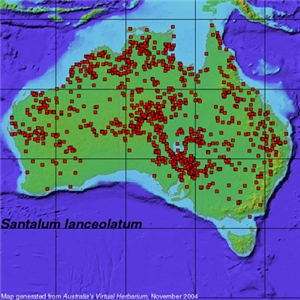Santalum
Voucher: Santalum lanceolatum R.Br. JAB123
Family: Santalaceae Common name(s): Plumbush, native plumbush, cherry bush, northern sandalwood, sandalwood
Habit: Shrub to 7 m tall. Distribution: Widespread in Australia, particularly in the tropics but extending south into arid Australia and South Australia, New South Wales and (rarely) Victoria.
General features: Density 900 kg/m3 . Pale wood with heartwood indistinct from sapwood. Odour present.
Microscopic features:
Vessels Tangential vessel diameter: range 12-56 µm; mean 28 µm; SD 14 µm; average maximum 38-48 µm; n = 344 vessels. Vessels per square millimetre: range 118-203 vessels per mm2; n = 3 sampled areas. Vessels solitary. Perforation plates simple with prominent rim.
*Fibres/tracheids With numerous, distinctly bordered pits present.
Axial parenchyma Axial parenchyma apotracheal and diffuse to diffuse-in-aggregate.
Rays Rays 2-3 cells wide with uniseriate rays absent (n = 31 rays). Rays of uniform width and not wider than vessels. Rays 7-17 per tangential mm (n = 8 sampled areas). Ray height: range 71-284 µm; mean 139 µm; SD 51 µm; n = 37 rays. Rays homocellular?
Helical thickenings Absent.
Physical and chemical tests: Chrome azurol-s test negative. Heartwood fluorescence absent. Froth test weakly positive. Ethanol extract fluorescence absent. Ethanol extract colourless. Water extract colourless. Water extract fluorescence absent.
Uses:
Aboriginal Spearthrower (Kamminga 2002)
European Carving; trinket boxes (Bootle 1983)
* At this stage the key makes no distinction between fibres and tracheids as they are difficult to tell apart and there is some confusion in the wood anatomical literature as to their definitions in hardwoods (IAWA: 264). For example, the taxa for which this character was predominantly included - Myrtaceae A (Eucalyptus & Melaleuca) - contain numerous, conspicuous bordered pits that are both called fibre tracheids (Dadswell 1972: 21) and vasicentric tracheids (IAWA: 262).

















